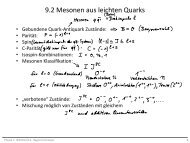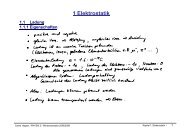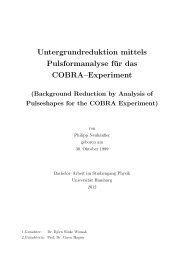Setup of a Drift Tube Muon Tracker and Calibration of Muon ...
Setup of a Drift Tube Muon Tracker and Calibration of Muon ...
Setup of a Drift Tube Muon Tracker and Calibration of Muon ...
You also want an ePaper? Increase the reach of your titles
YUMPU automatically turns print PDFs into web optimized ePapers that Google loves.
Figure 4.4: Principle <strong>of</strong> the three fold coincidence for the detection <strong>of</strong> cosmogenicbackground (Figure from [70]). If both the muon track <strong>and</strong> the position <strong>of</strong> the neutroncapture are reconstructed, events within the intersection <strong>of</strong> a cylinder around themuon track <strong>and</strong> a sphere around the neutron can be vetoed for a few half-lives <strong>of</strong> thecosmogenic induced radioisotope.since the low-energetic part <strong>of</strong> the cosmic muon spectrum is absorbed on its waythrough the rock.<strong>Muon</strong>s crossing the IV <strong>of</strong> the Borexino detector typically deposit hundreds <strong>of</strong>MeV <strong>of</strong> ionization energy in the detector <strong>and</strong> are thus easily discriminated fromthe solar neutrino signals. Special care has to be given to muons crossing onlythe buffer in the ID without passing through the IV. The light produced throughboth the Čerenkov effect in the buffer <strong>and</strong> from the remaining scintillation givesa significant signal despite the quenching effect <strong>of</strong> the DMP. Unfortunately, thesesignals can mimic the desired neutrino events. It is therefore necessary to effectivelytag <strong>and</strong> veto these muons.An even larger challenge are muon-induced cosmogenic events caused by spallation.The most prominent process is the knock-out <strong>of</strong> a neutron from the 12 C beingone <strong>of</strong> the main constituents <strong>of</strong> the scintillator. The remaining 11 C decays via a β +with a half-life <strong>of</strong> 20.39 minutes <strong>and</strong> a Q value <strong>of</strong> 1982.2 keV. The emitted positronthen almost instantly annihilates thus depositing a visible energy between ≈ 1 <strong>and</strong>2MeV in the detector which cannot be correlated to the incident muon anymore.Unfortunately, this signal overlays the energy range <strong>of</strong> CNO neutrinos <strong>and</strong> thereforehinders their detection. The expected rate for Borexino is 25 counts per day <strong>and</strong>dominates the CNO signal by approximately a factor <strong>of</strong> five [71].To suppress the cosmogenic background, the so-called three fold coincidence isused [72]. The neutron knocked out by the muons will be captured by a hydrogenatom after a typical time <strong>of</strong> ∼ 250ñs, which will then de-exite <strong>and</strong> release a 2.2 MeVphoton. This can be correlated to the crossing muon. Also, the position <strong>of</strong> theneutron capture can be reconstructed. Since its mean free path is rather short59





